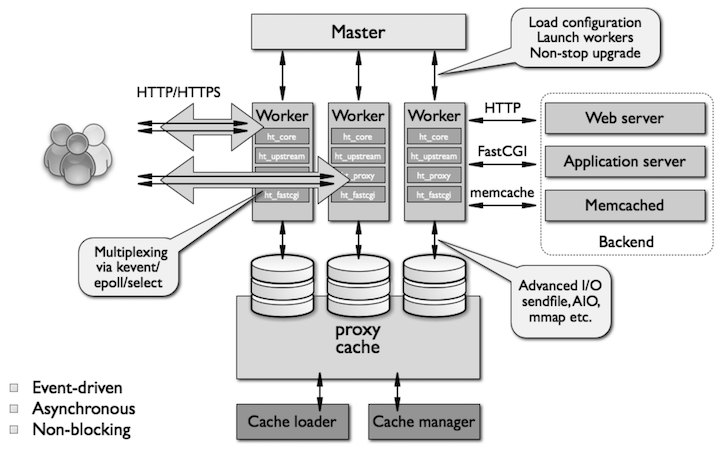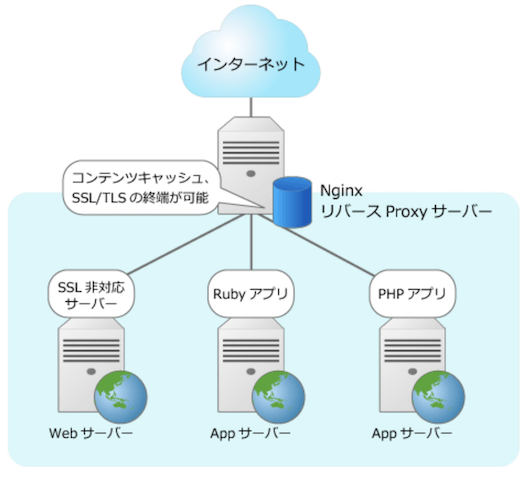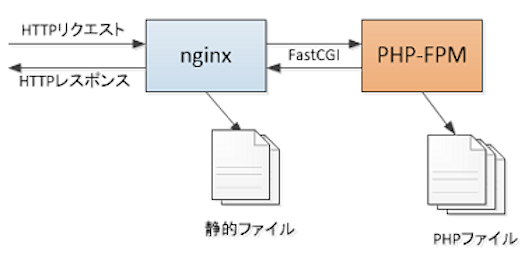Nginx@Web系ミドルウェア¶
はじめに¶
本サイトにつきまして、以下をご認識のほど宜しくお願いいたします。
01. Nginxの仕組み¶
アーキテクチャ¶

Nginxは、マスタープロセス、ワーカープロセス、プロキシキャッシュストレージ、キャッシュローダー、キャッシュマネージャー、といったコンポーネントから構成される。
Nginxの起動時に最初にマスタープロセスが実行され、Nginxに設定を適用する。
また、マスタープロセスは子プロセスとしてのワーカープロセスを実行し、各ワーカープロセスがリクエストを並列的に処理する。
ワーカープロセスは、キャッシュローダーを使用して、静的ファイル (例:htmlファイル、cssファイル、画像、動画、メールなど) のキャッシュをメモリ上のプロキシキャッシュストレージに保管し、一方で保管したキャッシュを取得する。
キャッシュマネージャは、保管したキャッシュの有効期限を管理する。
Radix Treeアルゴリズム¶
Nginxは、リクエストのIPアドレスを照合して、リクエストを許可/拒否する。
この時、Radix Treeアルゴリズムに基づいて、IPアドレスを高速で照合している。
モジュール¶
▼ 静的モジュール¶
静的モジュールは、ビルド後にNginxのバイナリに組み込む必要がある。
必要不要かにかかわらず、Nginxと一緒に強制的に実行する必要がある。
▼ 動的モジュール¶
動的モジュールは、ビルド後にNginxのバイナリに組み込む必要がない。
必要な場合にのみインストールし、また実行すればよい。
動的モジュールは、load_moduleディレクティブで読み込む。
load_module modules/<動的モジュール名>.so;
執筆時点 (2024/03/12) では、以下の動的モジュールがあらかじめインストールされている。
それ以外の動的モジュール (nginx-module-otel) はインストールする必要がある。
$ ls /etc/nginx/modules
ngx_http_geoip_module.so
ngx_http_js_module-debug.so
ngx_http_xslt_filter_module.so
ngx_stream_js_module-debug.so
ngx_http_image_filter_module-debug.so
ngx_http_js_module.so
ngx_stream_geoip_module-debug.so
ngx_stream_js_module.so
ngx_http_geoip_module-debug.so
ngx_http_image_filter_module.so
ngx_http_xslt_filter_module-debug.so
ngx_stream_geoip_module.so
Graceful Process¶
▼ Graceful Drain¶
▼ Graceful Shutdown¶
STOPSIGNAL SIGQUIT
02. ユースケース¶
リバースプロキシのミドルウェアとして¶
▼ 構成¶
Nginxを配置し、リクエストをWebサーバーにルーティングする。
リバースプロキシのミドルウェアとして使用する場合、Nginxをパブリックネットワークに公開しさえすれば、パブリックネットワークからNginxを介して、後段のWebサーバーにリクエストを送信できるようになる。
▼ HTTP/HTTPSプロトコルの場合¶
Nginxは、HTTP/HTTPSリクエストをルーティングする。
また、Appサーバーからのレスポンスの返信データが静的ファイルであった場合、これのキャッシュをプロキシキャッシュストレージに保管する。
以降に同じ静的ファイル (例:htmlファイル、cssファイル、画像、動画、メールなど) に関するインバウンド通信があった場合、NginxはAppサーバーにルーティングせずに、保管したキャッシュを取得し、レスポンスとして返信する。

*実装例*
#-------------------------------------
# HTTPリクエスト
#-------------------------------------
server {
server_name example.com;
listen 80;
return 301 https://$host$request_uri;
#-------------------------------------
# 静的ファイルであればNginxでレスポンス
#-------------------------------------
location ~ ^/(images|javascript|js|css|flash|media|static)/ {
root /var/www/foo/static;
expires 30d;
}
#-------------------------------------
# 動的ファイルであればWebサーバーにルーティング
#-------------------------------------
location / {
proxy_pass $scheme://$host$request_uri;
}
}
*実装例*
もし分散トレースを採用する場合、マイクロサービス間でトレースコンテキストを伝播する必要がある。
クライアント/サーバー側のリバースプロキシでトレースコンテキストを伝播できるようにする。
サービスメッシュツール (例:Istio) を使用すれば、これのサイドカープロキシが宛先のコンテナにトレースコンテキストを伝播してくれるが、Nginxであれば自前で実装する必要がある。
# クライアント側
http {
# $_request_id
log_format main '$remote_addr - $remote_user [$time_local] "$request_uri" '
'$status $body_bytes_sent "$http_referer" '
'"$http_user_agent" "$http_x_forwarded_for" "$_request_id"';
server {
listen 80;
# REQUEST-IDからリクエストIDを取得する
set $tmp $request_id;
# X-REQUEST-IDヘッダーにトレースIDがあれば、リクエストIDを上書きする
if ($http_x_request_id) {
set $tmp $http_x_request_id;
}
access_log logs/access.log main;
location / {
proxy_pass $scheme://$host$request_uri;
# X-REQUEST-IDヘッダーにトレースIDを設定し、リクエスト送信する
proxy_set_header X-Request-ID $tmp;
}
}
}
# サーバー側
http {
# $_request_id を参照する
log_format main '$remote_addr - $remote_user [$time_local] "$request_uri" '
'$status $body_bytes_sent "$http_referer" '
'"$http_user_agent" "$http_x_forwarded_for" "$_request_id"';
server {
listen 80;
# REQUEST-IDからリクエストIDを取得する
set $tmp $request_id;
# X-REQUEST-IDヘッダーにトレースIDがあれば、リクエストIDを上書きする
if ($http_x_request_id) {
set $tmp $http_x_request_id;
}
access_log logs/access.log main;
location = /server {
echo "This is server side";
}
}
}
▼ FastCGIプロトコルの場合¶

PHP-FPMはFastCGIプロトコルでリクエストを受信するため、これに変換する必要がある。
静的ファイル (例:htmlファイル、cssファイル、画像、動画、メールなど) のインバウンド通信が送信されてきた場合、Nginxはそのままレスポンスを返信する。
動的ファイルのインバウンド通信が送信されてきた場合、Nginxは、FastCGIプロトコルを介して、PHP-FPMにインバウンド通信をリダイレクトする。
# 設定ファイルのバリデーション
$ php-fpm -t
*実装例*
http {
#-------------------------------------
# HTTPリクエスト
#-------------------------------------
server {
listen 80;
server_name example.com;
root /var/www/foo/public;
index index.php index.html;
include /etc/nginx/default/nginx.conf;
#『/』で始まる全てのインバウンド通信の場合
location / {
try_files $uri $uri/ /index.php?$query_string;
}
#--------------------------------------------------
# インバウンド通信をFastCGIプロトコルでルーティングする。
# OSによって、fastcgi_paramsファイルの必要な設定が異なる
#--------------------------------------------------
location ~ \.php$ {
# ルーティング先のTCPソケット
fastcgi_pass 127.0.0.1:9000;
# もしくは、Unixドメインソケット
# fastcgi_pass unix:/run/php-fpm/www.sock;
# ルーティング先のURL (rootディレクティブ値+パスパラメータ)
fastcgi_param SCRIPT_FILENAME $document_root$fastcgi_script_name;
# 設定ファイルからデフォルト値を読み込む
include fastcgi_params;
}
}
}
▼ gRPCプロトコルの場合¶
Nginxは、HTTP/HTTPS/gRPCリクエストをgRPCとしてルーティングする。
stream {
server {
listen 8080 ssl http2;
server_name host.docker.internal;
ssl_certificate /ssl/localhost+1.pem;
ssl_certificate_key /ssl/localhost+1-key.pem;
ssl_protocols TLSv1.2 TLSv1.3;
ssl_prefer_server_ciphers on;
access_log /dev/stdout;
error_log /dev/stderr debug;
location ~ \.(html|js)$ {
root /var/www/html;
}
# HTTPSリクエストをマッチングする
location / {
grpc_set_header Content-Type application/grpc;
# gRPCサーバーにルーティングする
grpc_pass grpc://localhost:50051;
}
# gRPCリクエストをマッチングする
location /hello.HelloService/Hello {
grpc_set_header Content-Type application/grpc;
# gRPCサーバーにルーティングする
grpc_pass grpc://localhost:50052;
include common/cors.conf;
}
}
}
フォワードプロキシのミドルウェアとして¶
▼ 構成¶
フォワードプロキシのミドルウェアとして使用できる。
クライアントサイドにNginxを配置し、リクエストを外部ネットワークにルーティングする。
▼ HTTP/HTTPSプロトコルの場合¶
worker_processes 1;
events {
worker_connections 1024;
}
http {
include mime.types;
default_type application/octet-stream;
sendfile on;
keepalive_timeout 65;
server {
listen 3128;
proxy_connect;
proxy_connect_allow 443 563;
proxy_connect_connect_timeout 10s;
proxy_connect_read_timeout 10s;
proxy_connect_send_timeout 10s;
# 受信したリクエストを外部ネットワークにルーティングする。
location / {
proxy_pass $scheme://$host$request_uri;
proxy_set_header Host $host;
proxy_set_header X-Forwarded-Proto $scheme;
proxy_set_header X-Forwarded-For $proxy_add_x_forwarded_for;
proxy_set_header X-Forwarded-Port $remote_port;
}
}
}
L4/L7ロードバランサ-のミドルウェアとして¶
▼ L7ロードバランサーの場合 (実装がかなり複雑になる)¶
L7ロードバランサーとして使用できる。
Nginxは、HTTPプロコトルのインバウンド通信を複数のWebサーバーに負荷分散的に振り分ける。
受信した通信がHTTPプロトコルであった場合、HTTPSリクエストにリダイレクトすると良い。
また、HTTPSプロトコルであれば、HTTPに変換してルーティングすると良い。
ただし、HTTPSリクエストを受信するために、Nginxにサーバー証明書を設定する必要がある。
*実装例*
http {
# IPアドレスを定期的に取得する
resolver <DNSサーバーのIPアドレス> valid=5s;
# これで合ってるのかわからない...
upstream backend {
# 宛先のIPアドレスを動的に決める
server unix:/var/run/ip_addresses.sock weight=9 max_fails=1 fail_timeout=20s;
}
#-------------------------------------
# HTTPリクエスト
#-------------------------------------
server {
server_name example.com;
listen 80;
# リダイレクト
return 301 https://$host$request_uri;
}
#-------------------------------------
# HTTPSリクエスト
#-------------------------------------
server {
server_name example.com;
listen unix:/var/run/rds_1a_001.sock;
index index.php index.html;
#-------------------------------------
# SSL
#-------------------------------------
ssl on;
ssl_certificate /etc/nginx/ssl/server.crt;
ssl_certificate_key /etc/nginx/ssl/server.key;
add_header Strict-Transport-Security "max-age=86400";
# IPアドレスを動的に設定する
listen unix:/var/run/ip_addresses.sock;
set $ip_addresses "example.com";
location / {
proxy_pass $scheme://$ip_addresses;
proxy_set_header Host $host;
proxy_set_header X-Forwarded-Proto $scheme;
proxy_set_header X-Forwarded-For $proxy_add_x_forwarded_for;
proxy_set_header X-Forwarded-Port $remote_port;
}
}
}
▼ L4ロードバランサーの場合 (実装がかなり複雑になる)¶
Nginxは、TCPスリーウェイハンドシェイクを複数のサーバーにTCPプロトコルのまま負荷分散的に振り分ける。
L4ロードバランサーのため、宛先のサーバーでTCPプロトコルをHTTPプロトコルに変換するように処理しなければならない。
*実装例*
#-------------------------------------
# TCPスリーウェイハンドシェイク
#-------------------------------------
stream {
error_log /var/log/nginx/stream.log info;
proxy_protocol on;
# IPアドレスを定期的に取得する
resolver <DNSサーバーのIPアドレス> valid=5s;
# これで合ってるのかわからない...
upstream backend {
# 宛先のIPアドレスを動的に決める
server unix:/var/run/ip_addresses.sock weight=9 max_fails=1 fail_timeout=20s;
}
server {
# IPアドレスを動的に設定する
listen unix:/var/run/ip_addresses.sock;
set $ip_addresses "example.com";
location / {
proxy_pass $scheme://$ip_addresses;
}
}
}
APIゲートウェイとして¶
▼ APIゲートウェイに必要な機能¶
NginxをAPIゲートウェイとして使用する。
APIゲートウェイのため、リバースプロキシやロードバランサーとは異なり、以下の機能を持つ必要がある。
- 全てのAPIのセットとして機能し、受信した通信を適切なマイクロサービスのAPIにルーティング
- 認証
- トレースIDの付与
- キャッシュの作成
- リクエストのレートリミット
- パケットのアプリケーションデータの暗号化
- ...
▼ ルーティング¶
APIゲートウェイとしてのルーティングの機能であれば、難しい実装はいらない。
特定のパスに対するリクエストを特定のAPIにフォワーディングすれば良い。
*実装例*
server {
listen 80 default_server;
listen [::]:80 default_server;
# Products API
location /api/products {
proxy_pass http://products.api.com:80;
}
# Users API
location /api/users {
proxy_pass http://users.api.com:80;
}
}
- https://marcospereirajr.com.br/using-nginx-as-api-gateway-7bebb3614e48
- https://www.nginx.com/blog/deploying-nginx-plus-as-an-api-gateway-part-1/
- https://www.codingexplorations.com/blog/setting-up-an-api-gateway-using-nginx
- https://github.com/nanit/api-gateway-example/blob/master/app/services/authentication.conf
▼ 認証¶
Keycloakと連携し、NginxではなくKeycloak側で認証処理を実施する。
Nginx (Keycloakクライアント) は、Keycloakの認可エンドポイントにアクセストークン署名検証リクエストを送信する。
user nginx;
worker_processes 1;
events {
worker_connections 1024;
}
http {
include /etc/nginx/mime.types;
default_type text/html;
server {
listen 8080;
location /keycloak/ {
proxy_pass $scheme://<Keycloakのドメイン>/;
proxy_set_header Host $host;
proxy_set_header X-Real-IP $remote_addr;
proxy_set_header X-Forwarded-For $proxy_add_x_forwarded_for;
proxy_set_header X-Forwarded-Host $host;
proxy_set_header X-Forwarded-Server $host;
proxy_set_header X-Forwarded-Port $server_port;
proxy_set_header X-Forwarded-Proto $scheme;
}
location /keycloak/ {
# 認可エンドポイントにアクセストークン署名検証リクエストを送信する
proxy_pass $scheme://<Keycloakのドメイン>/realms/<realm名>;
proxy_set_header Host $host;
proxy_set_header X-Real-IP $remote_addr;
proxy_set_header X-Forwarded-For $proxy_add_x_forwarded_for;
proxy_set_header X-Forwarded-Host $host;
proxy_set_header X-Forwarded-Server $host;
proxy_set_header X-Forwarded-Port $server_port;
proxy_set_header X-Forwarded-Proto $scheme;
}
}
}